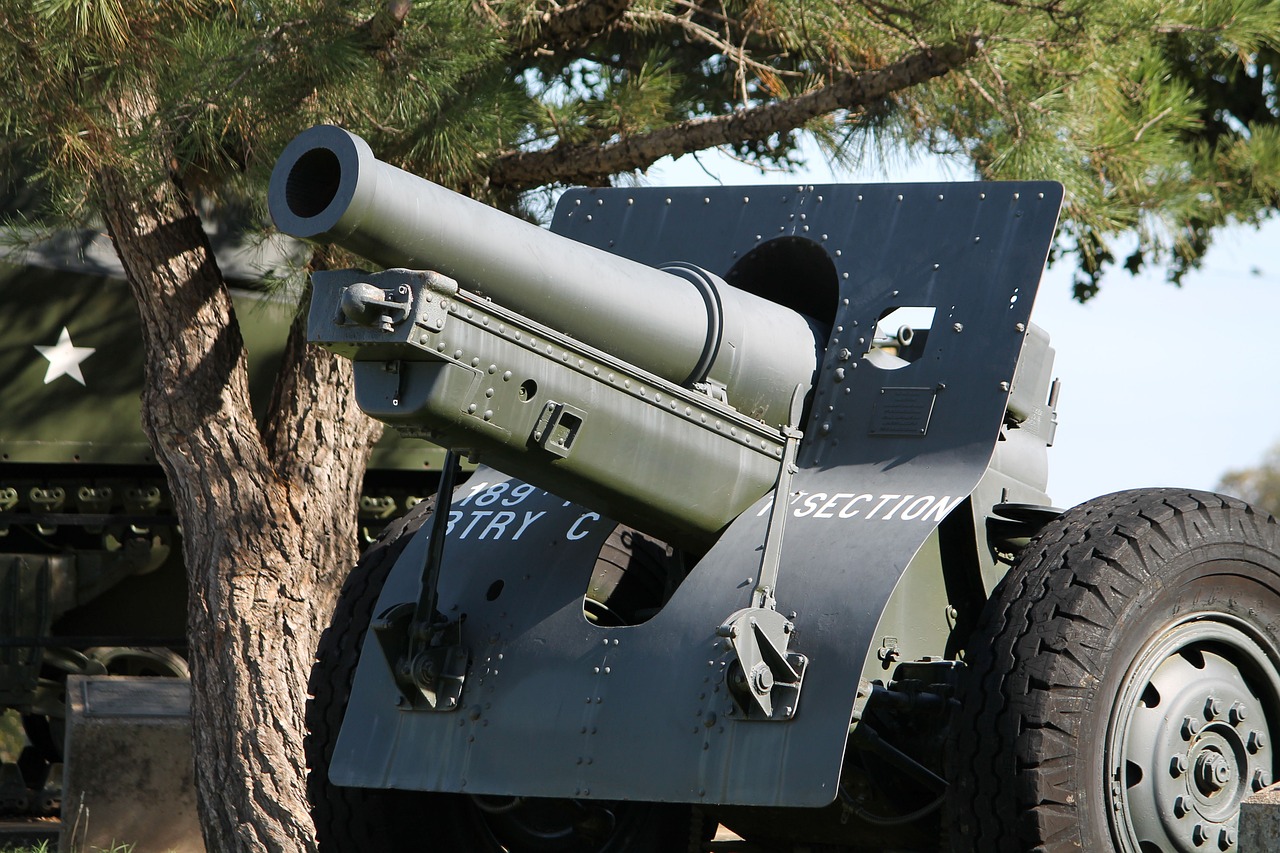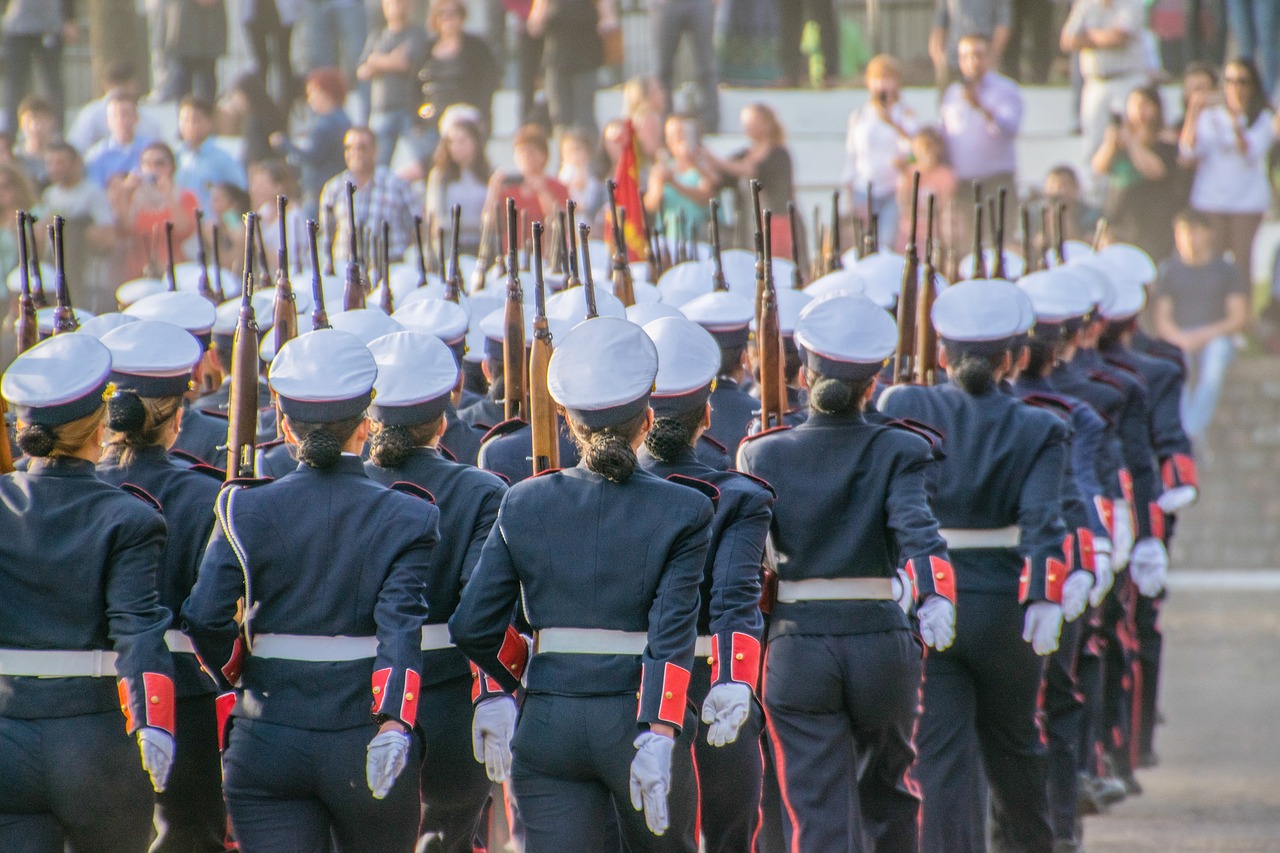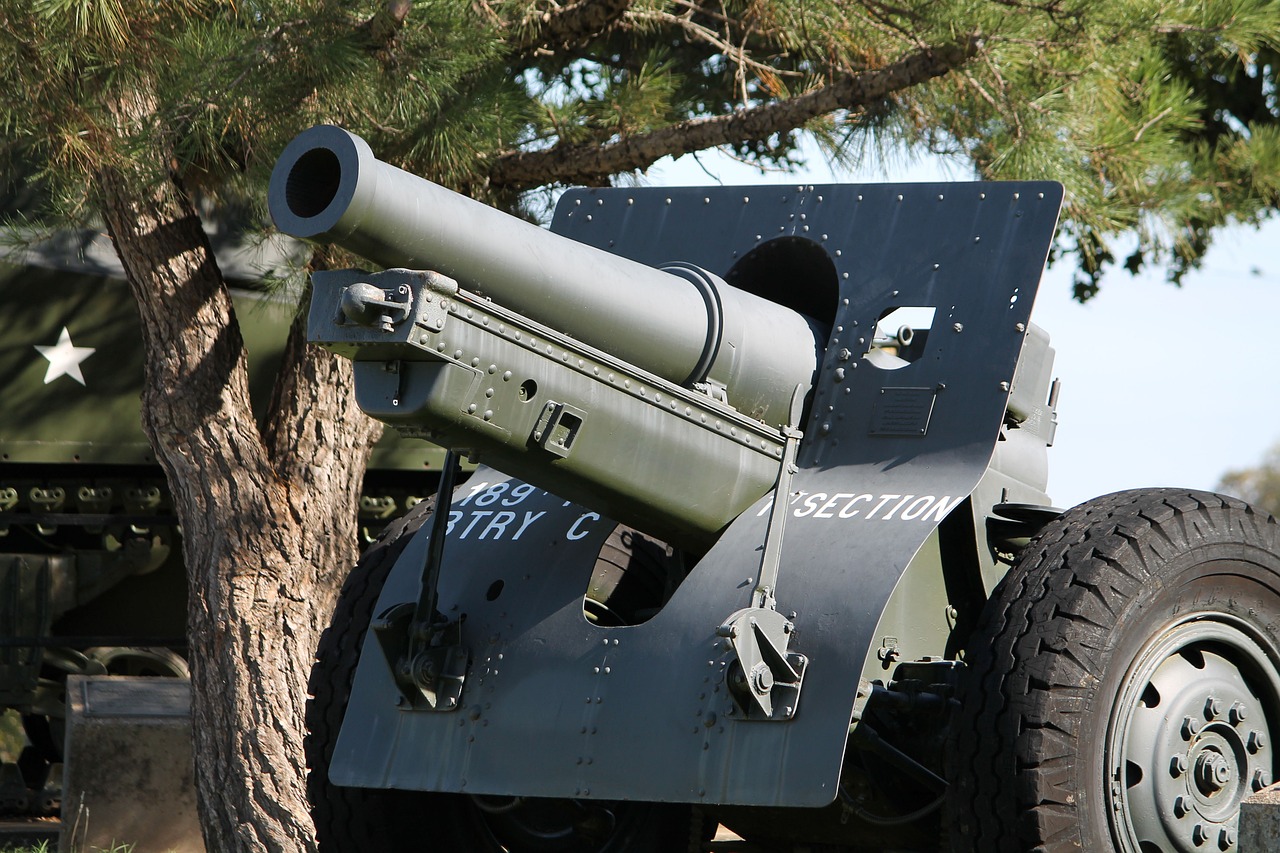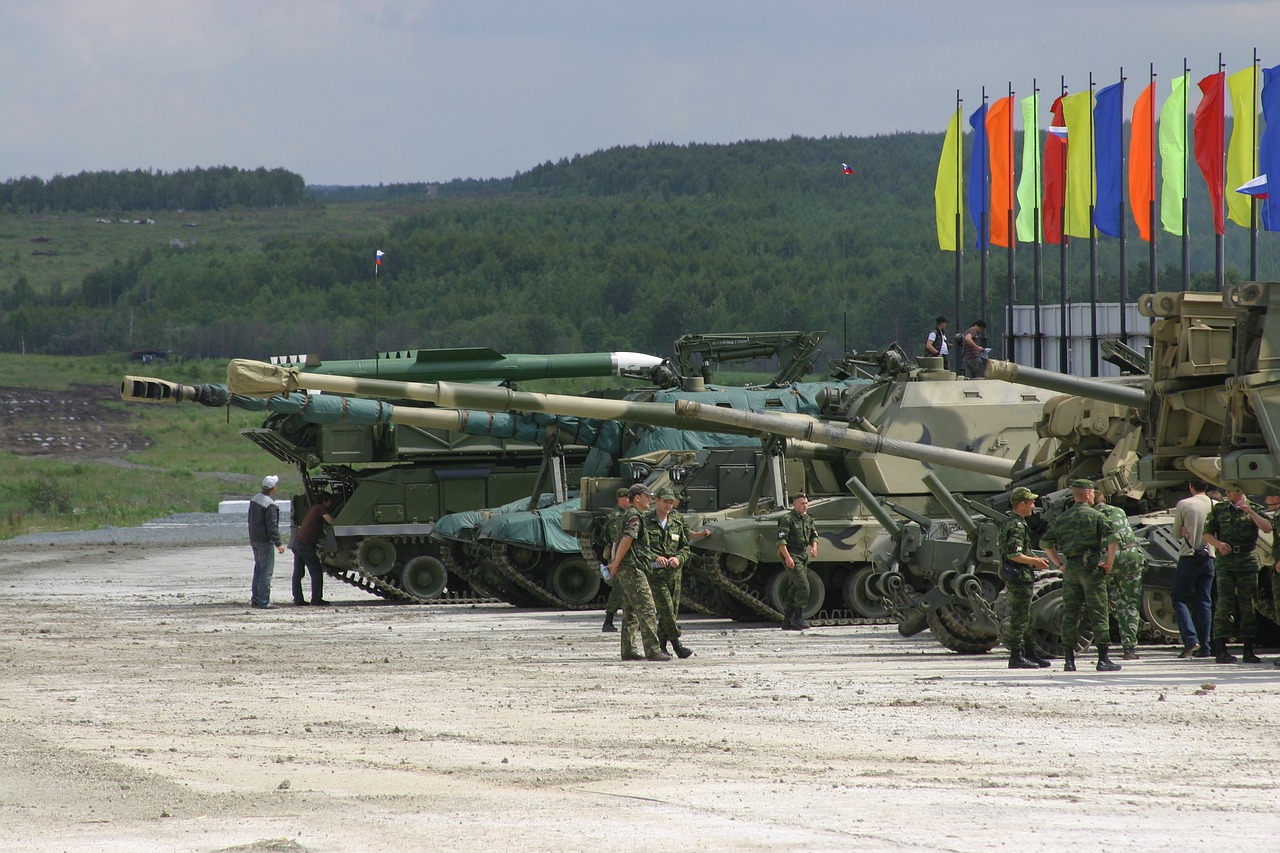Exploring the Use of AI in Combat Simulations
Artificial Intelligence (AI) is not just a buzzword; it has become a transformative force in various sectors, and the military is no exception. In combat simulations, AI is playing a pivotal role in reshaping how soldiers are trained, how strategies are developed, and how decisions are made during critical operations. Imagine a training environment where soldiers can face off against highly intelligent virtual opponents that adapt and respond in real time—this is the new frontier of military training, powered by AI.
As we dive deeper into this topic, it's essential to recognize that the integration of AI into combat simulations is not merely about technology; it's about enhancing human capabilities. The traditional methods of training, while effective to some extent, often fall short of preparing soldiers for the complexities of modern warfare. With AI, we can create a more immersive and realistic training experience that mirrors the unpredictability of real-life combat scenarios.
One of the most exciting aspects of AI in combat simulations is its ability to generate dynamic and realistic scenarios. Gone are the days when trainees would engage in predictable drills. Now, advanced algorithms can create a wide array of situations, from urban warfare to asymmetric conflicts, ensuring that soldiers are well-prepared for whatever challenges they may face on the battlefield. This adaptability is crucial, as it allows for a more comprehensive understanding of tactics and strategies.
Moreover, AI's capability to analyze vast amounts of data in real time offers another layer of sophistication to combat training. By monitoring each soldier's performance, AI systems can provide immediate feedback, pinpointing areas for improvement and suggesting tailored training exercises. This level of personalization ensures that every soldier can develop their skills at their own pace, maximizing their potential and readiness.
In short, the integration of AI in combat simulations represents a significant leap forward in military training. It not only enhances the realism of training exercises but also equips soldiers with the tools they need to succeed in an increasingly complex combat environment. But, as with any technological advancement, there are challenges and ethical considerations that must be addressed to fully harness the potential of AI in military contexts.
- What are the main benefits of using AI in combat simulations?
AI enhances realism, provides personalized training, and allows for real-time feedback, which collectively improve soldier preparedness. - Are there any ethical concerns associated with AI in military training?
Yes, there are concerns about desensitization to violence and the implications of relying on AI for critical decision-making. - How does AI improve the adaptability of training scenarios?
AI systems can analyze individual performance and modify training exercises to better suit each soldier's learning needs. - What challenges does the military face when implementing AI?
Technological limitations, ethical considerations, and the need for extensive training to use these systems effectively are significant challenges.

Understanding AI in Military Training
Artificial Intelligence (AI) is not just a buzzword; it's a revolutionary force reshaping the landscape of military training. Imagine stepping into a training environment that feels as real as a battlefield, where every decision you make can lead to victory or defeat. That's what AI brings to the table! By integrating sophisticated algorithms, military training programs can now create realistic scenarios that adapt to the trainee's actions and decisions. This means soldiers can experience a wide range of situations—everything from urban warfare to desert combat—without the inherent risks of live exercises.
One of the most exciting aspects of AI in military training is its ability to provide adaptive learning experiences. Traditional training often follows a one-size-fits-all approach, which can leave some soldiers underprepared while others may feel overwhelmed. However, AI-driven systems can analyze individual performance metrics in real-time, adjusting the difficulty and complexity of training scenarios to suit each soldier’s unique needs. This personalized approach not only enhances skill development but also boosts confidence, as trainees can practice at their own pace.
Furthermore, the implementation of AI technologies minimizes risks associated with conventional training methods. Think about it: live-fire exercises or complex tactical drills can be dangerous. With AI simulations, soldiers can train in a controlled environment where the stakes are lower, yet the learning outcomes are significantly higher. This allows military personnel to focus on mastering their skills without the fear of injury or mishaps.
In addition, AI can create a feedback loop that is crucial for improvement. After each training session, AI systems analyze performance data and provide immediate feedback. This instant evaluation helps soldiers identify their strengths and weaknesses, allowing them to refine their techniques and strategies. It's like having a personal coach who not only watches your every move but also offers tailored advice to help you improve. The combination of real-time feedback and adaptive learning truly transforms the training experience.
As we explore the potential of AI in military training, it's essential to recognize that this technology is still evolving. While the benefits are clear, the integration of AI also requires careful consideration of its implementation. Military organizations must ensure that they maintain a balance between technology and human judgment, as the ultimate goal is to enhance, not replace, the invaluable skills that soldiers possess.
- What are the main benefits of using AI in military training? AI provides realistic scenarios, adaptive learning experiences, and immediate feedback, enhancing skill development while minimizing risks.
- How does AI personalize training for soldiers? AI systems analyze individual performance metrics and adjust training scenarios to meet each soldier's unique strengths and weaknesses.
- What are the risks associated with AI in military training? While AI minimizes physical risks, there are concerns regarding over-reliance on technology and the potential for desensitization to violence.

Benefits of AI-Driven Simulations
Artificial Intelligence (AI) is not just a buzzword; it’s a game-changer in the realm of combat simulations. Imagine stepping into a training scenario that feels so real you can almost smell the gunpowder in the air. This is precisely what AI-driven simulations offer to military personnel. By harnessing advanced algorithms and machine learning, these simulations create a dynamic training environment that adapts to the needs of each soldier. This adaptability enhances the learning experience, making it not only more effective but also significantly more engaging.
One of the standout advantages of AI-driven simulations is their cost-effectiveness. Traditional training methods often require extensive resources, from live ammunition to physical training grounds. In contrast, AI simulations can replicate various combat scenarios without the hefty price tag associated with real-world training exercises. This means military budgets can be allocated more efficiently, allowing for more comprehensive training programs that can reach a larger number of soldiers.
Moreover, AI simulations excel in data analysis. They can process vast amounts of information in real time, offering insights that human instructors might miss. For instance, during a training exercise, AI can track each participant's performance metrics—like reaction times, decision-making speed, and accuracy. This data can then be analyzed to provide immediate feedback, which is crucial for continuous improvement. In this way, AI acts as a personal coach, highlighting strengths and pinpointing areas that need attention.
Another significant benefit is the enhanced realism that AI brings to training scenarios. With the ability to generate complex environments and situations, AI can create unpredictable enemy behavior that challenges soldiers to think on their feet. This unpredictability mimics real-world combat, where no two situations are identical. Trainees learn to adapt their strategies and develop critical thinking skills that are essential for success in the field.
Lastly, let's not overlook the impact of AI on strategic planning. By simulating various outcomes based on different tactics and decisions, military leaders can explore a multitude of strategies without real-world consequences. This capability allows for a more thorough understanding of potential scenarios, leading to better-prepared units and more informed decision-making processes. In essence, AI-driven simulations are not just about training soldiers; they are about shaping the future of military strategy.
- How does AI improve military training?
AI enhances military training by creating realistic scenarios, providing immediate feedback, and allowing for personalized learning experiences. - Are AI simulations cost-effective?
Yes, AI simulations reduce the need for expensive resources associated with traditional training methods, making them a more economical option. - What kind of data does AI analyze during simulations?
AI analyzes performance metrics such as reaction times, decision-making speed, and accuracy to help soldiers improve their skills. - Can AI simulate unpredictable enemy behavior?
Absolutely! AI can generate complex scenarios that mimic real-world combat, presenting trainees with challenges that require adaptive thinking.

Realistic Scenario Generation
In the realm of military training, the ability to create realistic scenarios is paramount. Imagine stepping into a virtual battlefield where every sound, movement, and decision feels as real as it would in actual combat. This is precisely what advanced algorithms and AI technologies are achieving today. By leveraging sophisticated modeling techniques, these systems can generate a plethora of scenarios that mirror real-world challenges faced by soldiers. This not only enhances the training experience but also prepares trainees for the unpredictable nature of warfare.
One of the standout features of AI-driven scenario generation is its capacity to simulate various environments and conditions. For instance, trainees can find themselves in urban settings, dense forests, or even arid deserts, each with its own unique set of challenges. The realism is further amplified by the incorporation of dynamic elements, such as weather changes and civilian presence, which complicate decision-making processes. This multifaceted approach ensures that soldiers are not only trained to execute tactics but also to think critically and adapt in the face of uncertainty.
Additionally, AI can create scenarios that evolve in real-time based on the actions of the trainees. This means that if a soldier makes an unexpected move, the AI can adjust the scenario to reflect that choice, perhaps by introducing new challenges or altering enemy behaviors. Such adaptability is crucial because it mimics the unpredictable nature of actual combat, where the enemy does not follow a script. The result? Soldiers become more versatile and better prepared to handle the chaos of real-life situations.
Moreover, the integration of AI in scenario generation allows for the analysis of vast amounts of data collected during training exercises. This data can be used to refine future scenarios, ensuring they remain relevant and challenging. By continuously improving the training environment, military organizations can maintain a high level of readiness among their personnel.
To illustrate the impact of realistic scenario generation, consider the following table that outlines key features and benefits:
| Feature | Benefit |
|---|---|
| Dynamic Environment Simulation | Enhances adaptability and decision-making skills. |
| Real-Time Scenario Adjustments | Prepares soldiers for unexpected challenges. |
| Diverse Combat Situations | Broadens tactical understanding and application. |
| Data-Driven Insights | Facilitates continuous improvement in training methods. |
In conclusion, the integration of AI in realistic scenario generation is not just a technological advancement; it is a transformative approach that shapes how military personnel prepare for the complexities of modern warfare. As these technologies continue to evolve, the potential for more immersive and effective training experiences will only grow, ultimately leading to better-prepared soldiers on the battlefield.
- What is realistic scenario generation in military training?
It refers to the use of AI to create immersive and unpredictable combat environments that mimic real-world challenges. - How does AI improve training effectiveness?
AI enhances training by providing dynamic scenarios that adapt to trainees’ actions, fostering critical thinking and adaptability. - Can AI-generated scenarios reflect different environments?
Yes, AI can simulate various terrains and conditions, such as urban areas, forests, and deserts, to prepare soldiers for diverse combat situations. - What are the benefits of using AI in scenario generation?
Benefits include enhanced adaptability, real-time adjustments, diverse combat situations, and data-driven insights for continuous improvement.

Dynamic Enemy Behavior
In the realm of combat simulations, is a game-changer. Imagine stepping into a virtual battlefield where the enemy is not just a static target but a cunning adversary that adapts and evolves based on your actions. This is the reality that AI brings to military training. By employing advanced algorithms, AI can simulate unpredictable enemy tactics and strategies, creating a more immersive and challenging environment for trainees. It's like playing a video game where the AI learns from your moves, making each encounter unique and demanding.
When soldiers engage in these simulations, they face a variety of scenarios that mimic real-world challenges. The AI can dynamically adjust the enemy's tactics, forcing trainees to think on their feet and adapt to changing battlefield conditions. This unpredictability not only enhances the training experience but also prepares soldiers for the chaos and uncertainty of actual combat situations. For instance, if a trainee consistently uses a particular strategy, the AI can respond by altering its approach, such as flanking maneuvers or ambush tactics, thereby keeping the trainee on their toes.
This adaptability is crucial because it reflects the real-world complexities of warfare. In a traditional training setting, soldiers might practice against predictable opponents, leading to a false sense of security. However, with AI-driven simulations, they learn to anticipate and counter a wide range of enemy behaviors, which could mean the difference between success and failure in the field. The ability to experience and react to dynamic enemy behavior not only builds confidence but also sharpens decision-making skills under pressure.
Furthermore, the integration of allows for extensive data collection during training sessions. Instructors can analyze how trainees respond to various enemy tactics, identifying strengths and weaknesses in their approach. This data-driven feedback loop is invaluable for refining training programs and enhancing overall performance. It’s akin to having a personal coach who not only critiques your performance but also adjusts the game plan to ensure you’re always improving.
In conclusion, the impact of dynamic enemy behavior in combat simulations is profound. By creating a realistic and unpredictable training environment, AI helps soldiers develop the skills they need to navigate the complexities of modern warfare. As technology continues to evolve, the potential for even more sophisticated enemy simulations is limitless, promising an exciting future for military training.
- What is dynamic enemy behavior in combat simulations?
Dynamic enemy behavior refers to the AI's ability to simulate unpredictable and adaptive tactics of opponents, creating a more realistic training environment for military personnel. - How does AI improve military training?
AI enhances military training by providing realistic scenarios, analyzing trainee performance, and adapting training exercises to individual needs, ultimately improving decision-making and preparedness. - What are the benefits of using AI in combat simulations?
Benefits include increased efficiency, cost-effectiveness, personalized training experiences, and the ability to analyze vast data sets for improved strategic planning. - Are there any challenges associated with AI in military training?
Yes, challenges include technological limitations, ethical concerns regarding desensitization to violence, and the need for extensive training to use AI systems effectively.

Adaptive Learning Mechanisms
In the realm of military training, the integration of powered by artificial intelligence is nothing short of a game changer. Imagine a training environment that evolves in real-time, adjusting to the strengths and weaknesses of each soldier. This is precisely what AI brings to the table, creating a dynamic learning experience that is tailored to individual needs. With AI, the training process becomes less about a one-size-fits-all approach and more about personalized growth.
One of the most remarkable features of these adaptive systems is their ability to analyze performance metrics instantaneously. For example, during a simulated combat scenario, AI can track various data points such as reaction times, decision-making speed, and accuracy of actions. By processing this data, the AI can identify specific areas where a soldier may struggle. This could be anything from tactical decision-making under pressure to effective communication with team members. Once identified, the system can modify subsequent training sessions to focus on these areas, ensuring that each soldier is not just practicing but improving.
Consider this: if a soldier consistently performs well in certain aspects but struggles with strategic planning, AI can introduce more complex scenarios that require advanced strategy. This might involve simulating a multi-faceted battlefield where decisions have cascading effects. As soldiers navigate these challenges, they receive real-time feedback, allowing them to adjust their strategies on the fly. This feedback loop is crucial; it not only reinforces learning but also builds confidence as soldiers see tangible improvements in their skills.
Moreover, the adaptability of AI systems means that they can cater to different learning paces. Some soldiers may grasp concepts quickly, while others might need more time. AI ensures that everyone progresses at their own speed, which can significantly enhance the overall effectiveness of military training programs. This personalized approach helps to foster a sense of ownership in the learning process, making soldiers more engaged and motivated.
To illustrate the effectiveness of adaptive learning mechanisms, let’s take a look at a simplified table that outlines how AI adjusts training based on performance:
| Performance Metric | AI Response | Training Adjustment |
|---|---|---|
| Slow reaction times | Increase scenario intensity | Focus on quick decision-making drills |
| Poor communication | Introduce team-based challenges | Emphasize communication strategies |
| High accuracy but low strategy | Complex scenario simulations | Encourage strategic thinking exercises |
This table exemplifies how AI can provide tailored adjustments to training based on real-time analysis. By leveraging these adaptive learning mechanisms, military training can become more effective, engaging, and ultimately, more successful in preparing soldiers for the complexities of modern warfare.
- What are adaptive learning mechanisms in military training?
Adaptive learning mechanisms utilize AI to customize training experiences based on the individual performance of soldiers, allowing them to improve in specific areas. - How does AI provide feedback during training?
AI analyzes various performance metrics in real-time and offers immediate feedback, helping soldiers recognize their strengths and areas for improvement. - Can AI adjust training scenarios on the fly?
Yes, AI can modify training scenarios based on real-time performance data, ensuring that each soldier receives the most relevant training experience. - What are the benefits of personalized training?
Personalized training enhances engagement, motivation, and skill acquisition, making soldiers better prepared for actual combat situations.

Data Analysis and Feedback
This article delves into the integration of artificial intelligence in combat simulations, examining its impact on training, strategy development, and decision-making processes within military contexts.
AI technologies are revolutionizing military training by providing realistic scenarios and adaptive learning experiences, allowing soldiers to enhance their skills in a controlled environment while minimizing risks associated with traditional training methods.
AI-driven simulations offer numerous advantages, such as increased efficiency, cost-effectiveness, and the ability to analyze vast amounts of data, ultimately leading to improved decision-making and strategic planning in combat situations.
Advanced algorithms enable the creation of highly realistic combat scenarios, allowing trainees to experience a variety of situations that mimic real-world challenges, thereby enhancing their preparedness for actual missions.
AI can simulate unpredictable enemy tactics and strategies, providing trainees with a more challenging and engaging environment to hone their skills and adapt to changing battlefield conditions.
AI systems can analyze individual performance and adjust training scenarios accordingly, ensuring that each soldier receives personalized instruction tailored to their unique strengths and weaknesses.
One of the most significant advantages of integrating AI into combat simulations is its ability to enhance . Imagine a virtual training ground where every move, decision, and outcome is meticulously tracked and analyzed in real time. This is precisely what AI brings to the table. During training exercises, AI can collect a myriad of data points—from the speed of decision-making to the accuracy of shots fired. This data is then processed to provide immediate feedback to trainees, which is crucial for identifying areas of improvement.
For instance, after a simulated mission, soldiers can receive detailed reports highlighting their strengths and weaknesses. This data-driven approach ensures that training is not just about repetition but about continuous improvement. AI can even categorize feedback into various metrics, such as:
- Decision-Making Speed: How quickly a soldier assesses a situation and responds.
- Accuracy: The precision of actions taken during the simulation.
- Strategic Adaptability: The ability to change tactics based on evolving scenarios.
Furthermore, this data can be aggregated across multiple training sessions, allowing military trainers to identify trends and adjust training programs accordingly. For example, if a group of trainees consistently struggles with a specific type of scenario, instructors can modify the training to focus more on that area. This level of customization is invaluable, as it transforms training from a one-size-fits-all model into a tailored experience that addresses the unique needs of each soldier.
Ultimately, the integration of AI in data analysis not only enhances individual performance but also contributes to a more effective overall training program. By harnessing the power of AI, military organizations can ensure that their personnel are not only prepared for the challenges they will face but are also equipped with the skills necessary to adapt and thrive in unpredictable combat environments.
Despite the benefits, integrating AI into combat simulations presents challenges such as technological limitations, ethical concerns, and the need for extensive training to effectively utilize these advanced systems.
Current AI technologies may struggle with certain complex scenarios, which can lead to gaps in realism and effectiveness during training exercises, necessitating ongoing research and development in the field.
The use of AI in combat simulations raises ethical questions regarding the potential for desensitization to violence and the implications of relying on machines for critical decision-making in military operations.
- What are the main advantages of using AI in combat simulations?
AI enhances realism, provides personalized feedback, and allows for the analysis of vast amounts of data, leading to improved training outcomes. - How does AI improve decision-making in military training?
AI analyzes performance data and offers immediate feedback, helping soldiers refine their tactical approaches and strategies. - Are there ethical concerns associated with AI in military training?
Yes, there are concerns about desensitization to violence and the reliance on AI for critical military decisions. - What challenges do military organizations face when implementing AI?
Challenges include technological limitations, ethical dilemmas, and the need for extensive training to utilize AI effectively.

Challenges of Implementing AI in Combat Simulations
As we delve deeper into the realm of artificial intelligence (AI) in combat simulations, it’s essential to recognize that the journey is not without its challenges. While the benefits are compelling, the integration of AI technologies into military training and strategy development does pose significant hurdles. One of the primary challenges is the technological limitations of current AI systems. Although these systems are designed to create realistic training environments, they can sometimes struggle with complex scenarios. This limitation can lead to gaps in realism, which can hinder the effectiveness of training exercises. Imagine trying to prepare for a chess match against a grandmaster, but your training partner only knows how to play checkers—it just doesn't cut it!
Moreover, the ethical considerations surrounding AI in combat simulations cannot be overlooked. There is a growing concern that reliance on AI could lead to a desensitization to violence among military personnel. When soldiers train with AI systems that simulate combat, they may become accustomed to the idea of machines making life-and-death decisions. This raises profound questions about the morality of allowing algorithms to influence critical decision-making processes in real-world military operations. Are we ready to hand over the reins to machines, or is that a slippery slope we should avoid?
Furthermore, the successful implementation of AI in combat simulations requires extensive training for military personnel. Soldiers must not only learn how to operate these advanced systems but also understand the underlying algorithms that drive them. This necessity for training can create a bottleneck in the adoption of AI technologies, as resources must be allocated not only for the technology itself but also for the human capital needed to utilize it effectively. It’s akin to buying a state-of-the-art car but not knowing how to drive—what’s the point?
In addition to these challenges, there are also concerns regarding data security and privacy. The integration of AI in combat simulations often involves the collection and analysis of vast amounts of data. This data can include sensitive information about military strategies, troop movements, and even personal data about soldiers. Ensuring the security of this data is paramount, as breaches could have dire consequences for national security. Imagine a scenario where an adversary gains access to training data and uses it to their advantage—it's a nightmare scenario that military leaders are keen to avoid!
Despite these challenges, the potential for AI to revolutionize combat simulations is undeniable. As technology continues to evolve, it is crucial for military organizations to address these hurdles head-on. By investing in research and development, establishing ethical guidelines, and providing comprehensive training, the military can harness the full power of AI while mitigating the risks involved.
- What are the primary challenges of implementing AI in combat simulations?
The main challenges include technological limitations, ethical concerns regarding desensitization to violence, the need for extensive training, and data security issues.
- How does AI enhance military training?
AI enhances military training by creating realistic scenarios, simulating dynamic enemy behavior, and providing personalized feedback to soldiers.
- What ethical concerns are associated with AI in military contexts?
Ethical concerns include the potential desensitization to violence and the implications of relying on machines for critical decision-making in combat situations.
- How can the military address the challenges of AI implementation?
The military can address these challenges through ongoing research and development, establishing ethical guidelines, and providing comprehensive training for personnel.

Technological Limitations
While the integration of artificial intelligence in combat simulations is undeniably transformative, it is not without its challenges. One of the primary concerns is the that current AI systems face. For instance, although these systems can process vast amounts of data and simulate various scenarios, they often struggle with complex, unpredictable situations that are characteristic of real-world combat. This limitation can lead to a lack of realism in training exercises, which in turn may hinder a soldier's ability to react effectively in genuine combat conditions.
Moreover, the algorithms that drive these simulations require extensive amounts of data to function optimally. In many cases, the data necessary to create highly accurate simulations may be incomplete or unavailable. As a result, the AI might generate scenarios that do not fully represent the nuances of actual military engagements. This gap can create a false sense of security among trainees, who might believe they are better prepared than they truly are.
Another significant challenge is the computational power required to run advanced AI simulations. High-fidelity simulations demand robust hardware and software infrastructure, which can be costly and logistically challenging to implement across various military training facilities. This can lead to disparities in training quality between different units, with some having access to cutting-edge technology while others are left with outdated systems.
Lastly, the rapid pace of technological change means that military organizations must continually adapt and update their systems. This ongoing need for research and development can strain budgets and resources, making it difficult for military leaders to keep pace with the latest advancements in AI technology. As such, while the potential of AI in combat simulations is vast, significant hurdles remain that must be addressed to fully realize its benefits.
- What are the main technological limitations of AI in combat simulations?
Current AI systems may struggle with complex scenarios, require extensive data, and demand significant computational power, which can lead to unrealistic training experiences. - How can technological limitations affect military training?
Limitations can create gaps in realism, potentially leading to inadequate preparation for soldiers facing real-world combat situations. - What is being done to overcome these technological challenges?
Ongoing research and development efforts are crucial, alongside investments in infrastructure and training to enhance AI capabilities in military contexts.

Ethical Considerations
As we dive deeper into the integration of artificial intelligence (AI) in combat simulations, we cannot overlook the ethical considerations that accompany this technological advancement. The military's reliance on AI raises profound questions about the morality of using machines to make critical decisions that can impact human lives. Imagine a soldier in a high-pressure situation, relying on algorithms to guide their actions. Are we risking the human touch that is so essential in warfare, or are we enhancing our capabilities to save lives?
One of the primary concerns is the potential for desensitization to violence. When soldiers engage in simulations that replicate combat scenarios with AI-driven enemies, there’s a risk that the line between training and reality becomes blurred. If the experience is too realistic, it could lead to a mindset where violence is normalized, making it easier for soldiers to engage in lethal actions without fully grasping the moral weight of their decisions.
Moreover, the decision-making process in military operations is inherently complex, often requiring a nuanced understanding of human emotions and ethical dilemmas. Can we trust AI to navigate these complexities? There’s a fear that over-reliance on AI systems might lead to a diminished sense of accountability. If a machine makes a mistake, who is responsible? The programmer? The military leader? This ambiguity raises significant ethical questions about accountability and the potential for unintended consequences.
To address these ethical dilemmas, it is crucial to engage in ongoing dialogue among military leaders, ethicists, and technologists. Here are some considerations that should be part of this conversation:
- Transparency: The algorithms and decision-making processes used in AI systems should be transparent to ensure that all stakeholders understand how decisions are made.
- Accountability: Establish clear lines of accountability for decisions made by AI systems to prevent the diffusion of responsibility.
- Training and Education: Incorporate ethical training for military personnel to prepare them for the implications of using AI in combat scenarios.
Ultimately, while AI has the potential to revolutionize military training and combat simulations, we must tread carefully. Balancing technological advancement with ethical responsibility is not just a challenge; it’s an imperative that will shape the future of warfare. As we continue to explore the capabilities of AI, we must also ensure that we uphold our moral obligations to humanity.
- What are the main ethical concerns regarding AI in combat simulations?
The primary concerns include desensitization to violence, accountability for decisions made by AI, and the potential loss of human judgment in critical situations. - How can military organizations address these ethical considerations?
By promoting transparency in AI processes, establishing clear accountability, and incorporating ethical training into military education. - Is AI capable of making moral decisions in combat scenarios?
Currently, AI lacks the ability to understand human emotions and complex ethical dilemmas, making it unreliable for moral decision-making. - What role does training play in mitigating ethical risks associated with AI?
Training helps soldiers understand the implications of using AI, ensuring they remain accountable and aware of the moral dimensions of their actions.
Frequently Asked Questions
- What is the role of AI in military training simulations?
AI plays a crucial role in military training by creating realistic scenarios that allow soldiers to practice their skills in a safe environment. It adapts to individual performance, providing personalized training experiences that enhance learning and readiness for real-world missions.
- How do AI-driven simulations improve decision-making in combat situations?
AI-driven simulations analyze vast amounts of data to provide insights that help military personnel make informed decisions. By simulating various combat scenarios and enemy behaviors, these systems enable soldiers to refine their strategies and respond effectively to dynamic battlefield conditions.
- What are some benefits of using AI in combat simulations?
There are numerous benefits, including increased efficiency, cost-effectiveness, and the ability to generate realistic training scenarios. AI can also provide immediate feedback, helping trainees identify areas for improvement and enhancing their overall performance.
- What challenges are associated with implementing AI in military training?
While AI offers many advantages, there are challenges such as technological limitations that may hinder realism, ethical concerns regarding desensitization to violence, and the need for extensive training to effectively use these advanced systems.
- How does AI create realistic combat scenarios?
Advanced algorithms enable AI to generate diverse and intricate combat scenarios that mimic real-world challenges. This level of realism helps soldiers prepare for various situations they may encounter during actual missions.
- Can AI adapt training scenarios based on individual performance?
Yes! AI systems have the capability to analyze each soldier's performance in real-time and adjust training scenarios accordingly. This ensures that the training is tailored to the unique strengths and weaknesses of each individual, promoting effective learning.
- What ethical concerns arise from using AI in combat simulations?
Ethical concerns include the potential for desensitization to violence and the implications of relying on machines for critical decision-making. These issues highlight the need for careful consideration and oversight in the development and deployment of AI technologies in military contexts.



















